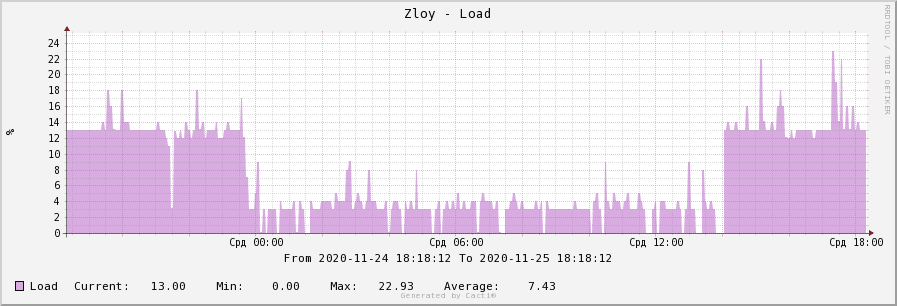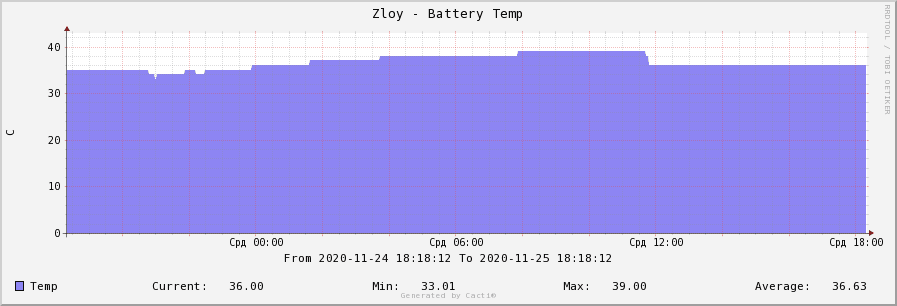How to monitor USB UPS status via SNMP
There are several computers with USB-connected UPS. All the computers use the apcupsd program. Say you want to aggregate information about the state of the power supply for every unit in one place. Since snmpd is already running there, it would be logical to expand its functionality.
Advertisеment
The below solution, courtesy of the Admin's Blog, will collect the data from all snmpd units at once.
In order to monitor USB UPS status via SNMP, we need to first modify the snmp daemon config.
Preparations
Adds the following to the config snmpd.conf.
# APC UPSpass .1.3.6.1.4.1.318.1.1.1 /bin/sh /etc/snmp/apcupsd.sh
The contents of the /etc/snmp/apcupsd.sh script is as follows.
#!/bin/sh -f
# Check apcupsd is online
apcaccess > /dev/null 2>&1 || exit 0
PLACE=".1.3.6.1.4.1.318.1.1.1"
REQ="$2" # Requested OID
#
# Process SET requests by simply logging the assigned value
# Note that such "assignments" are not persistent,
# nor is the syntax or requested value validated
#
if [ "$1" = "-s" ]; then
echo $* >> /tmp/passtest.log
exit 0
fi
#
# GETNEXT requests - determine next valid instance
#
if [ "$1" = "-n" ]; then
case "$REQ" in
$PLACE| \
$PLACE.0| \
$PLACE.0.*| \
$PLACE.1| \
$PLACE.1.1.0*) RET=$PLACE.1.1.1.0 ;;
$PLACE.1*| \
$PLACE.2.0| \
$PLACE.2.0.*| \
$PLACE.2.1| \
$PLACE.2.2.0*) RET=$PLACE.2.2.1.0 ;;
$PLACE.2.2.1*) RET=$PLACE.2.2.2.0 ;;
$PLACE.2.2.2*) RET=$PLACE.2.2.3.0 ;;
$PLACE.2.2.3*) RET=$PLACE.2.2.4.0 ;;
$PLACE.2*| \
$PLACE.3.0*| \
$PLACE.3.1*| \
$PLACE.3.2.0*) RET=$PLACE.3.2.1.0 ;;
$PLACE.3.2.1*| \
$PLACE.3.2.2*| \
$PLACE.3.2.3*) RET=$PLACE.3.2.4.0 ;;
$PLACE.3.2.4*) RET=$PLACE.3.2.5.0 ;;
$PLACE.3.2*| \
$PLACE.4.0*| \
$PLACE.4.1*| \
$PLACE.4.2.0*) RET=$PLACE.4.2.1.0 ;;
$PLACE.4.2.1*) RET=$PLACE.4.2.2.0 ;;
$PLACE.4.2.2*) RET=$PLACE.4.2.3.0 ;;
$PLACE.4.2.3*) RET=$PLACE.4.2.4.0 ;;
$PLACE.4.2.*| \
$PLACE.5*| \
$PLACE.6*| \
$PLACE.7.0*| \
$PLACE.7.1*| \
$PLACE.7.2.0*| \
$PLACE.7.2.1*| \
$PLACE.7.2.2*) RET=$PLACE.7.2.3.0 ;;
$PLACE.7.2.3*) RET=$PLACE.7.2.4.0 ;;
$PLACE.7*| \
$PLACE.8.0*) RET=$PLACE.8.1.0 ;;
*) exit 0 ;;
esac
else
#
# GET requests - check for valid instance
#
case "$REQ" in
$PLACE.1.1.1.0| \
$PLACE.2.2.1.0| \
$PLACE.2.2.2.0| \
$PLACE.2.2.3.0| \
$PLACE.2.2.4.0| \
$PLACE.3.2.1.0| \
$PLACE.3.2.4.0| \
$PLACE.3.2.5.0| \
$PLACE.4.2.1.0| \
$PLACE.4.2.2.0| \
$PLACE.4.2.3.0| \
$PLACE.4.2.4.0| \
$PLACE.7.2.3.0| \
$PLACE.7.2.4.0| \
$PLACE.8.1.0) RET=$REQ ;;
*) exit 0 ;;
esac
fi
#
# "Process" GET* requests - return hard-coded value
#
echo "$RET"
case "$RET" in
$PLACE.1.1.1.0) echo "string"; apcaccess -u -p MODEL ; exit 0 ;;
$PLACE.2.2.1.0) echo "Gauge32"; apcaccess -u -p BCHARGE ; exit 0 ;;
$PLACE.2.2.2.0) echo "Gauge32"; apcaccess -u -p ITEMP ; exit 0 ;;
$PLACE.2.2.3.0) echo "Timeticks"; echo $(($(LC_ALL=C printf "%.*f" 0 $(apcaccess -u -p TIMELEFT)) * 6000)) ; exit 0 ;;
$PLACE.2.2.4.0) echo "string"; apcaccess -u -p BATTDATE ; exit 0 ;;
$PLACE.3.2.1.0) echo "Gauge32"; apcaccess -u -p LINEV ; exit 0 ;;
$PLACE.3.2.4.0) echo "Gauge32"; apcaccess -u -p LINEFREQ ; exit 0 ;;
$PLACE.3.2.5.0) echo "string"; apcaccess -u -p LASTXFER ; exit 0 ;;
$PLACE.4.2.1.0) echo "Gauge32"; apcaccess -u -p OUTPUTV ; exit 0 ;;
$PLACE.4.2.2.0) echo "Gauge32"; apcaccess -u -p LINEFREQ ; exit 0 ;;
$PLACE.4.2.3.0) echo "Gauge32"; apcaccess -u -p LOADPCT ; exit 0 ;;
$PLACE.4.2.4.0) echo "Gauge32"; apcaccess -u -p LOADPCT ; exit 0 ;;
$PLACE.7.2.3.0) echo "string"; apcaccess -u -p SELFTEST ; exit 0 ;;
$PLACE.7.2.4.0) echo "string"; apcaccess -u -p SELFTEST ; exit 0 ;;
$PLACE.8.1.0) echo "Gauge32"; echo 1 ; exit 0 ;;
*) echo "string"; echo "ack... $RET $REQ"; exit 0 ;; # Should not happen
esac
If you are wondering about OIDs, you can find them HERE. Note that some UPS models do not return all parameters or in the wrong format, so the code may contain inaccuracies and stubs.
Now you are ready.
How to monitor USB UPS status via SNMP
To monitor USB UPS status via SNMP, run the following command: snmpwalk -v 1 -c public 127.0.0.1 .1.3.6.1.4.1.318.1.1.1. The output will be like that:
SNMPv2-SMI::enterprises.318.1.1.1.1.1.1.0 = STRING: "Smart-UPS 750 "
SNMPv2-SMI::enterprises.318.1.1.1.2.2.1.0 = Gauge32: 100
SNMPv2-SMI::enterprises.318.1.1.1.2.2.2.0 = Gauge32: 36
SNMPv2-SMI::enterprises.318.1.1.1.2.2.3.0 = Timeticks: (432000) 1:12:00.00
SNMPv2-SMI::enterprises.318.1.1.1.2.2.4.0 = STRING: "2020-05-14"
SNMPv2-SMI::enterprises.318.1.1.1.3.2.1.0 = Gauge32: 227
SNMPv2-SMI::enterprises.318.1.1.1.3.2.4.0 = Gauge32: 50
SNMPv2-SMI::enterprises.318.1.1.1.3.2.5.0 = STRING: "Automatic or explicit self test"
SNMPv2-SMI::enterprises.318.1.1.1.4.2.1.0 = Gauge32: 227
SNMPv2-SMI::enterprises.318.1.1.1.4.2.2.0 = Gauge32: 50
SNMPv2-SMI::enterprises.318.1.1.1.4.2.3.0 = Gauge32: 13
SNMPv2-SMI::enterprises.318.1.1.1.4.2.4.0 = Gauge32: 13
SNMPv2-SMI::enterprises.318.1.1.1.7.2.3.0 = STRING: "NO"
SNMPv2-SMI::enterprises.318.1.1.1.7.2.4.0 = STRING: "NO"
SNMPv2-SMI::enterprises.318.1.1.1.8.1.0 = Gauge32: 1
If you further configure the monitoring script, you can get these nifty graphs:




Support us
Winaero greatly relies on your support. You can help the site keep bringing you interesting and useful content and software by using these options:
